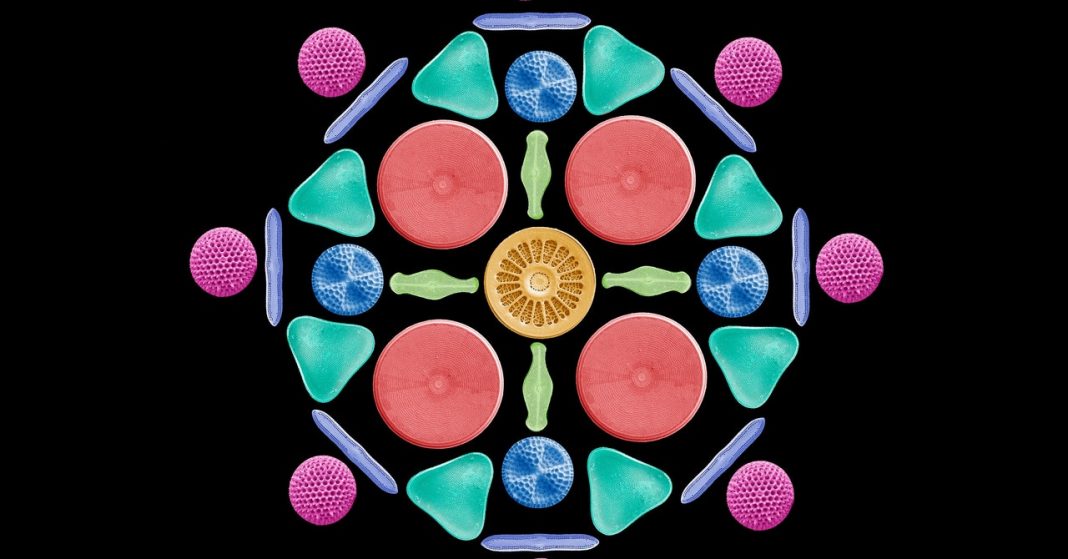A dense rainforest or other verdant terrestrial vegetation may be what first comes to mind at the mention of photosynthesis. Yet the clouds of phytoplankton that fill the oceans are the major drivers of that process in nature. The plantlike single-celled aquatic microbes generate more than 50 percent of the oxygen in the atmosphere, and they absorb nearly half of the carbon dioxide, converting it into the glucose, fats, proteins and other organic molecules that nourish the food web of the oceans.
A recently published study in Current Biology finally pins down the source of this unparalleled photosynthetic efficiency, which has long baffled scientists. The new research found that some phytoplankton are equipped with an extra internal membrane that carries a “proton pump” enzyme that supercharges their ability to convert carbon dioxide into other substances. The enhancements due to this one protein modification seem to contribute to the production of nearly 12 percent of the oxygen in the air and as much as 25 percent of all the carbon “fixed” (locked into organic compounds) in the ocean.
Surprisingly, that photosynthetic innovation seems to have evolved by chance from a membrane protein that was originally used for digestion in the ancestor of the phytoplankton. In addition to explaining the cells’ prowess at photosynthesis, the new work helps to confirm the theory that those phytoplankton arose through a symbiotic alliance between a protozoan and a resilient red alga.
“I find it staggering that a proton enzyme that we have known for so many decades is responsible for maintaining such a crucial phenomenon on Earth,” said Dennis Brown, a cell biologist at Harvard Medical School who studies the functions of membrane proteins and was not involved in the study.
Researchers knew that certain classes of phytoplankton—diatoms, dinoflagellates, and coccolithophores—stand out for their exceptional photosynthetic abilities. Those cells are extremely proficient at absorbing carbon dioxide from their environment and directing it to their chloroplasts for photosynthesis, but the details of why they are so good at it haven’t been very clear. A feature unique to those three groups of phytoplankton, however, is that they have an extra membrane around their chloroplasts.
Seven years ago, the microbiologist Daniel Yee, the lead author on the new study, was studying diatoms for his doctorate at the Scripps Institution of Oceanography at the University of California, San Diego. Photosynthesis wasn’t his focus; he sought to understand how diatoms regulate their internal acidity to help with nutrient storage and to build their tough silica cell wall. But he kept noticing the unique additional membrane around their chloroplasts.
He learned that the extra membrane was widely regarded by researchers as a remnant of an ancient, failed act of digestion. Scientists hypothesized that about 200 million years ago, a predatory protozoan tried to feast on a single-celled photosynthetic alga. It enveloped the resilient alga in a membrane structure called a food vacuole to digest it, but for unknown reasons, digestion did not occur. Instead, the alga survived and became a symbiotic partner to the protozoan, feeding it the fruits of its photosynthesis. This partnership deepened over the generations until the new two-in-one organism evolved into the diatoms we know today. But the extra layer of membrane that had been a food vacuole never disappeared.
In the late 1990s, some scientists hypothesized that the former food vacuole was still likely to carry a transmembrane channel protein called a proton pump. Proton pumps are highly versatile molecules that can be specialized for diverse tasks in organisms, from digestion to regulating blood acidity to helping neurons send signals, explained the microbiologist Martin Tresguerres, the senior coauthor of the new study and Yee’s former adviser at UCSD. In mammals, one type of proton pump can create highly corrosive acidic conditions within areas of bones to break down their mineralized structure and dissolve them over time.
